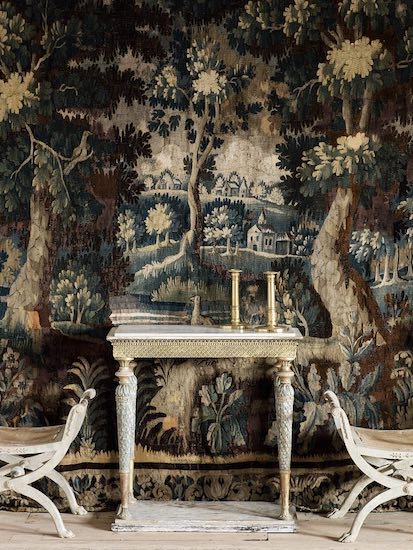Verdure.
Verdure.
Elaborate verdure tapestries adorn the walls of Hatfield House, the grand Jacobean estate in Hertfordshire, England, used as the primary filming location for The Favourite, set during the reign of Queen Anne.
Deriving from ‘vert’, the French word for green, a verdure is a tapestry representing a landscape, woven from the 15th to the 18th century, notably at tapestry centers in Oudenarde in Belgium and Aubusson and Lille in France. It’s not certain when verdure tapestries were first produced but it is known that by the 16th century, they had become a recognized tapestry art form.
An Early 18th Century Flemish Verdure Tapestry. Photo: D Larsson Interior
Tapestry evolved from early methods of basket weaving however, instead of grasses and woods, linen, flax, wool, silk and yarn was used. What originally functioned as roughly-hewn clothing, bedding, rugs and makeshift home insulation soon became what was regarded, in certain cultures and eras, as amongst the highest of art forms. In ancient Greece, loomed murals were ubiquitous to prominent homes and public buildings. It’s thought the Parthenon’s walls were adorned with ornate tapestries, many depicting the gods’ mythical exploits.
Tapestries became a means of reflecting the lives and times of their weavers, chronicling major political, religious and mythical subjects, often through symbolism and allegory. By the Middle Ages, traveling royals and nobles retained tapestry weavers as servants to produce woven depictions of current events - often historically as in the Bayeux Tapestry’s documentation of the Battle of Hastings in 1066. The weavers that remained at the home-front created richly-hued lengths of fabric depicting soldiers in action, field workers, and ladies and lovers in gardens bursting with detailed flowers and verdure.
Tapestry became a means of reflecting the lives and times of their weaver, chronicling major political events and battles.
Following the Hundred Year War (1337 to 1453) when many weavers left France and many tapestries were destroyed, a new period of learning and artistic development began. Throughout the Renaissance, tapestry prospered and from the 14th to the 17th century, France and the Low Countries produced some of the finest tapestry art ever produced.
A Gobelins tapestry representing Neptune.
Initially, verdure tapestries were characterized by their green tones, complex foliage and flowers, with forests and woodlands being typical scenes. However, as their popularity rose throughout the 17th century, more elaborate, expansive designs incorporating wildlife were woven - these are what we most typically associate with verdure today. In some verdure tapestries the animals are in a peaceful setting and in others, savaging each other.
At Château du Champ de Bataille, above a Georges Jacob sofa bearing the stamps of Maire-Antoinette at the chateau of Fontainebleau, a Brussels tapestry depicts the signs of the zodiac and months of the year. Here, a war allegory represents the month of March while in the middle ground, gardeners tend a handsome French garden.
The Unicorn in Captivity. Part of The Unicorn Tapestries, which are amongst the most significant tapestries ever created.
Verdure shouldn’t be confused with ‘Menues Verdure’ or ‘Millefleur’ tapestry. Millefleur (literally ‘thousand flowers’) tapestry is characterized by a background motif of many small flowers, the floral decoration predominantly serving as a backdrop for the figurative elements of the design. Millefleur tapestries were first made in the Loire Valley in France in the 15th century and were produced in France and the Low Countries until the end of the 16th Century. The Hunt of the Unicorn tapestries, chronicling the fate of a mythical creature construed to be that of Christ, are examples of 15th century millefleurs and are some of textile art history’s most prized treasures. In legend, the unicorn was associated with chastity and invulnerability, since only a virgin might catch and tame it, and its horn was considered an antidote to poison. They were gifted by J.D. Rockefeller to the Met Museum in the 1930’s and are now housed at the Cloisters.






